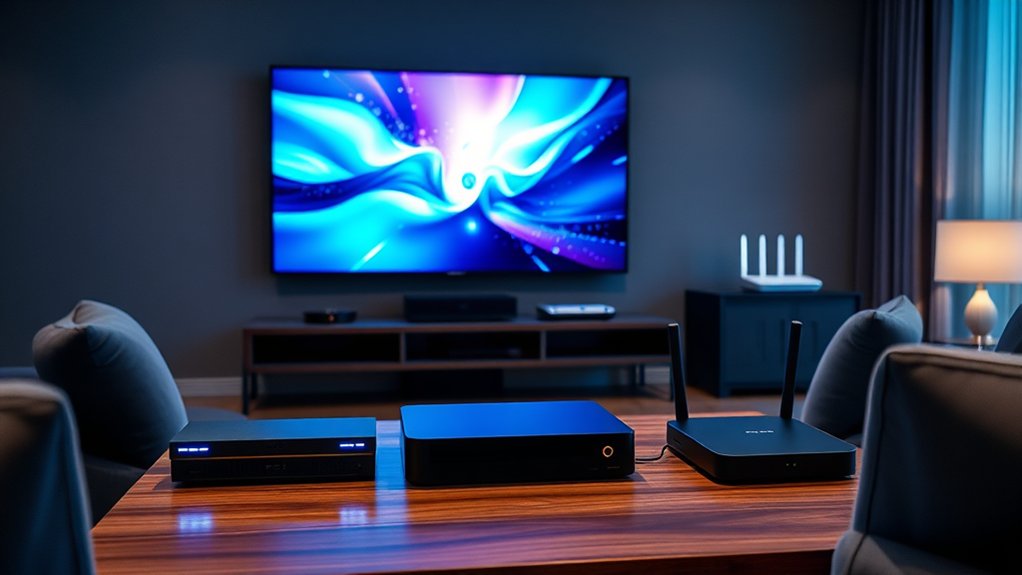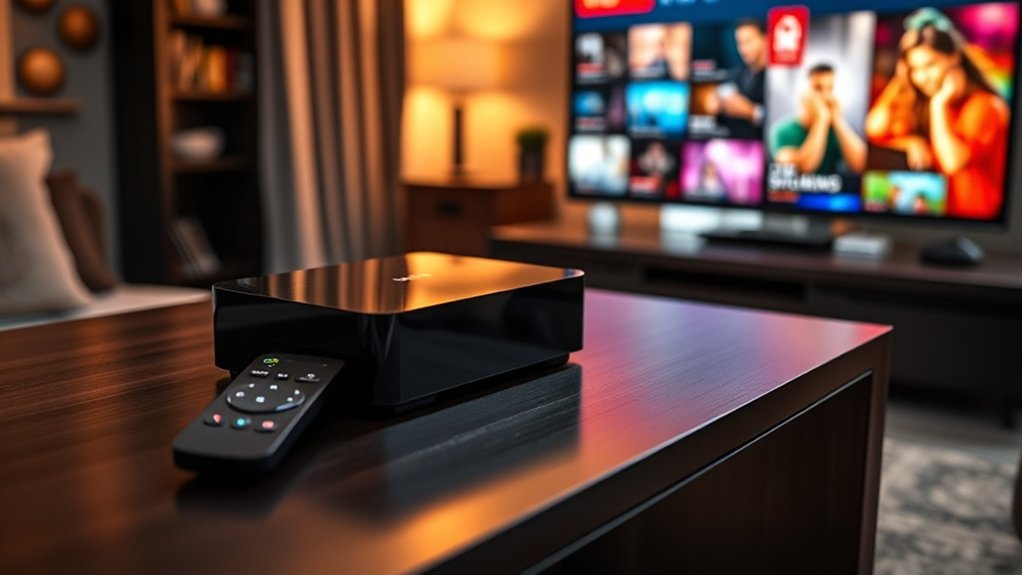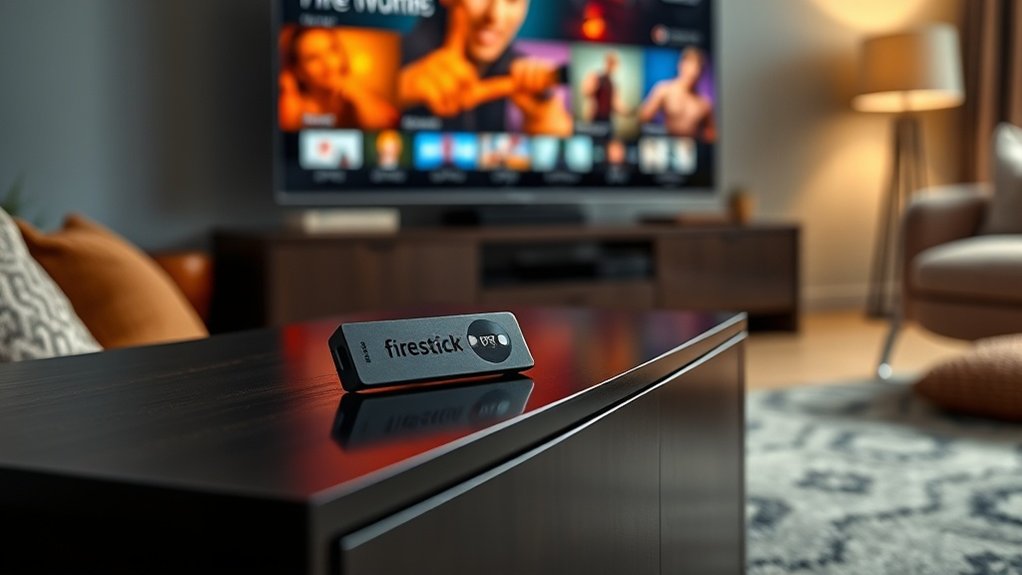If you’re aiming for high bitrate home streaming, consider devices like the Nvidia Shield TV Pro, Apple TV 4K (2022 Model), or Roku Ultra. These gadgets handle demanding content effortlessly. The Shield TV, with its powerful GPU and AI upscaling, shines for gamers. Meanwhile, Apple TV integrates smoothly with its ecosystem, enhancing viewing experiences. And don’t forget Roku with its user-friendly interface. Curious to see how these devices stack up in price and features?
Key Highlights
- Nvidia Shield TV Pro supports seamless 4K HDR streaming with AI-enhanced upscaling for lower-resolution content.
- Apple TV 4K (2022 Model) efficiently handles high-bitrate content, providing superior picture quality through its advanced A15 Bionic chip.
- Google TV Streamer offers 4K HDR at 60 fps, supporting a vast library of content while integrating smart home devices.
- Amazon Fire TV Stick 4K Max features a powerful quad-core processor, enhancing loading times and streaming performance overall.
- Roku Ultra ensures high bitrate streams are managed effectively, combining user-friendly navigation with fast performance improvements over previous models.
Nvidia Shield TV: A Powerhouse for Streaming

If you’re searching for a streaming device that truly packs a punch, search no more than the Nvidia Shield TV Pro; it’s not just a pretty face in your entertainment setup.
This powerhouse features the NVIDIA Tegra X1+ processor and a 256-core GPU, providing seamless 4K HDR streaming at up to 120 fps. The AI-enhanced upscaling takes your lower-resolution content and raises it to near-4K quality—pretty nifty, right? Plus, with Dolby Atmos support, your movie nights become immersive experiences. The device supports Dolby Audio and DTS-X surround sound, further elevating your audio experience. The dual-band Wi-Fi and Gigabit Ethernet guarantee smooth streaming without interruptions, and those USB 3.0 ports? They’re perfect for expanding your media library! It’s like having a high-performance gaming console and a media center in one sleek package. Additionally, the accelerated learning programs at Portland Code School emphasize tools that can enhance streaming and media management experiences.
Apple TV 4K (2022 Model): Seamless Integration and Performance
When you plunge into the world of home streaming, the Apple TV 4K (2022 Model) stands out for its impressive synergy of performance and seamless integration with the Apple ecosystem.
Thanks to the A15 Bionic chip, it’s 50% faster than its predecessor, effortlessly handling high-bitrate content and HDR up to 60 frames per second. Third-Generation Apple TV 4K introduces passive cooling with a fanless design, eliminating noise disruptions during your favorite shows. Additionally, users can enjoy superior picture performance with crisp, detailed images that enhance the viewing experience.
With options for 64GB or 128GB storage, the latter includes features like a Gigabit Ethernet port for a reliable wired connection—perfect for binge-watching without buffering, right?
The compact design and fanless operation mean it won’t disrupt your favorite shows.
Plus, Wi-Fi 6 improves streaming stability, so you can enjoy sharp visuals and dependable audio, all while Siri is at your beck and call.
Google TV Streamer: Unified Browsing Experience

As you plunge into the capabilities of the Google TV Streamer, you’ll quickly notice how it brings together your favorite apps, shows, and smart home devices into one cohesive experience.
With 4 GB of RAM, it handles multitasking with ease, allowing you to switch between Netflix and your smart thermostat without missing a beat. Its 32 GB storage means more room for apps and content, as well as 4K HDR video at 60 fps, along with Dolby Atmos support, guarantees your viewing experience is spectacular. Moreover, it supports over 700,000 movies and TV shows, ensuring you’ll always have something to watch.
Plus, with it functioning as a Thread hub, controlling smart home gadgets is a breeze. After all, why juggle multiple remotes when your Google TV Streamer can unify everything? It’s like having a personal assistant for your entertainment!
Amazon Fire TV Stick 4K Max: Value and Functionality
After examining how the Google TV Streamer unifies your entertainment experience, let’s shift gears to the Amazon Fire TV Stick 4K Max, a device that brings impressive value and functionality to your living room setup.
With a powerful quad-core processor and improved GPU, you’ll enjoy rapid loading times and fluid gaming. Plus, it supports Wi-Fi 6E, ensuring buttery-smooth streaming without annoying buffering.
Picture yourself watching 4K Ultra HD content with stunning HDR, as Dolby Atmos surround sound raises your audio. The Fire OS smartly connects you to popular apps like Netflix and Disney+.
Oh, and let’s not forget the Alexa remote—who doesn’t want to control everything with just their voice? It’s convenience at its finest!
Roku Ultra: Reliable Connectivity and User-Friendly Interface

There’s something to be said for a streaming device that not only delivers fast performance but moreover makes your viewing experience intuitive and enjoyable.
The Roku Ultra excels in both areas, being a whopping 30% faster than previous models. With its upgraded processor, you can effortlessly handle high bitrate streams without a hitch.
Plus, Wi-Fi 6 integration gives you stable connectivity, crucial for those who don’t want buffering interrupting movie night.
The user-friendly interface makes finding your favorite shows a breeze, whereas the Roku Voice Remote Pro adds convenience with hands-free controls.
It’s kind of like having a personal assistant—minus the coffee runs! If you’re serious about streaming, Roku Ultra offers exceptional performance and ease of use.
High Bitrate Streaming Requirements
Streaming at high bitrates doesn’t just hinge on your device’s capabilities; it requires a solid grasp of your internet connection and home network setup.
For instance, if you’re aiming for smooth 1080p at 60 fps, you’ll need at least 6,000 kbps. That’s quite a leap from the mere 3,000 kbps for 720p at 30 fps, right?
It’s crucial to verify your upload speeds exceed your streaming bitrate by 20-30% for stable performance. Plus, using a Constant Bitrate (CBR) mode prevents those frustrating buffering moments, whereas a proper keyframe interval—around 2 seconds—can greatly improve responsiveness.
Importance of Ethernet and Wi-Fi 6
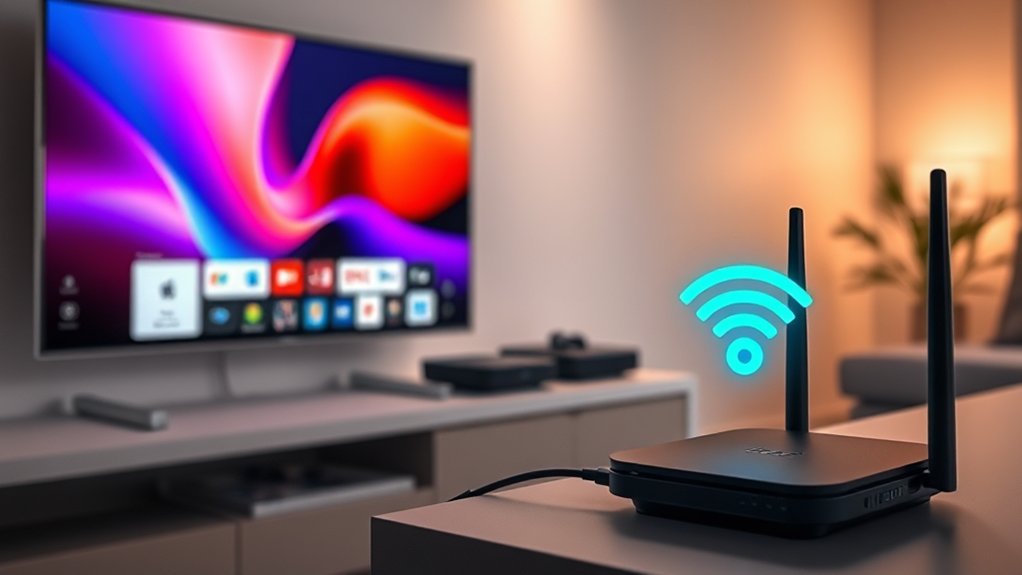
Even though it may seem tempting to rely solely on Wi-Fi for your home streaming needs, understanding the distinct advantages offered by Ethernet and Wi-Fi 6 can truly improve your viewing experience.
Ethernet provides a stable, wired connection, eliminating interference issues that can plague Wi-Fi, ensuring you enjoy consistent high bitrate streaming. With gigabit speeds, it’s perfect for 4K and beyond, allowing for multiple streams without buffering—a win-win for binge-watchers, right?
Conversely, Wi-Fi 6 boosts performance in crowded homes, managing simultaneous devices more effectively. It increases throughput and reduces latency, keeping your streams clear and smooth.
Audio Support and Immersive Experiences
When you plunge into the world of home entertainment, the audio experience can make or break your immersion in a movie or show. Devices supporting Dolby Atmos deliver those spine-tingling moments, wrapping you in sound that seems to twirl around you—just like the action on screen.
Although Dolby Atmos reigns, you might furthermore stumble upon DTS:X lurking in some devices, providing its own impressive soundstage. Most popular streamers back standard surround sound formats, ensuring you won’t miss out on that cinematic thrill.
If you crave precision, lossless codecs like FLAC enhance sound quality to audiophile levels. Moreover, seamless hardware compatibility means you can investigate diverse content effortlessly—because who doesn’t want a home theater that feels like the real deal? The technology behind Dolby Atmos enables sound to move freely in three-dimensional space, creating an unparalleled auditory environment.
Smart Home Integration Advantages
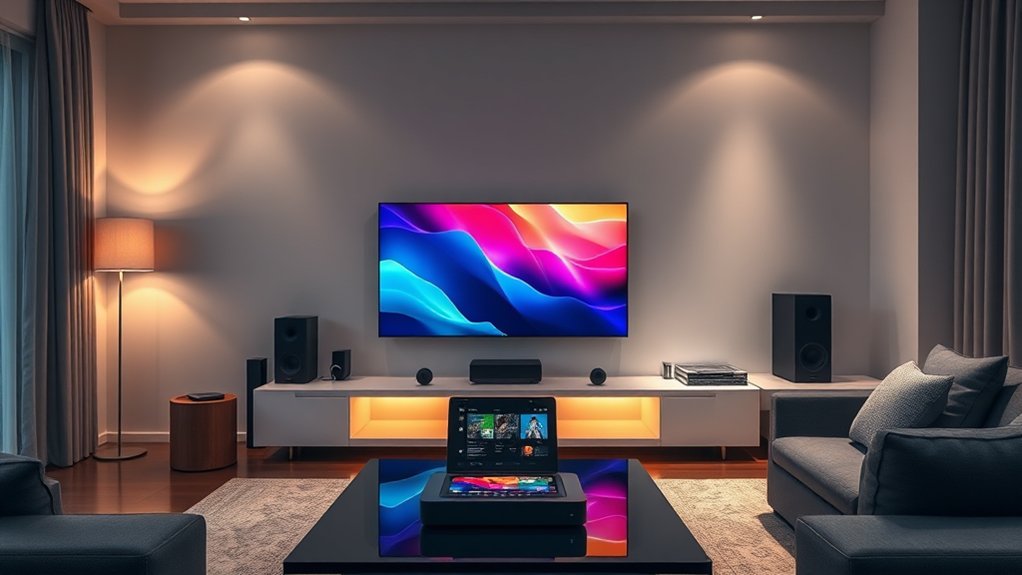
In today’s tech-savvy world, the integration of smart home devices has become a game-changer for how you enjoy entertainment, making everything from binge-watching a drama to hosting a movie night smoother than ever.
With seamless interoperability, your devices work in harmony, allowing smooth content flow across multiple rooms. Imagine using a single remote, like the Amazon Fire TV Cube, to control everything—less clutter, more fun!
Plus, voice assistants like Alexa provide hands-free control, taking convenience to a new level. Automated routines can dim lights and adjust sound when streaming starts, immersing you in the experience.
Isn’t it nice to have everything working together as you just kick back and enjoy your show?
Comparing Price Points for High-End Devices
Have you ever wondered why some high-end streaming devices come with such hefty price tags? It primarily boils down to the specs and features they offer.
Take the Nvidia Shield TV, for example; priced between $150 and $200+, it packs powerful hardware and gaming capabilities, making it perfect for serious streamers.
Then there’s the Apple TV 4K, similarly around $150 to $180, which blends smooth performance with seamless integration into the Apple ecosystem.
On the more budget-friendly side, the Amazon Fire TV Stick 4K Max offers 4K support for around $50 to $70, providing decent value without all the bells and whistles.
In the end, you get what you pay for, especially regarding high-resolution streaming and advanced features.
Frequently Asked Questions
Can I Use These Devices Without a Smart TV?
Yes, you can definitely use these devices without a smart TV. They connect via HDMI, stream high bitrate content independently, and control everything through their interfaces and remotes, giving you access to all streaming features.
How Do I Set up These Devices for Streaming?
To set up your streaming devices, connect them via HDMI, configure network settings, adjust video output for 4K HDR, facilitate audio passthrough if possible, and ascertain your internet supports high bitrate requirements for peak performance.
Will I Need Additional Subscriptions for 4K Content?
Yes, you’ll need additional subscriptions for 4K content. Most streaming platforms require specific plans for UHD access, so check their offerings to guarantee you can enjoy high-quality streaming without interruptions or limitations.
Can I Play Games on These Streaming Devices?
Yes, you can play games on these streaming devices. Each offers unique gaming capabilities, whether it’s the Nvidia Shield’s strong performance, Apple TV’s arcade access, or Google TV’s smart integration. You’ll enjoy diverse gaming experiences.
Do All Devices Require a 4K TV to Function?
No, not all devices require a 4K TV to function. You can use them with non-4K TVs, but you’ll only get the maximum resolution the TV supports, which often is lower than 4K.

